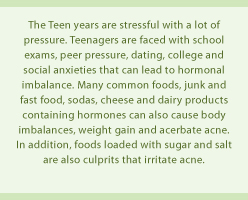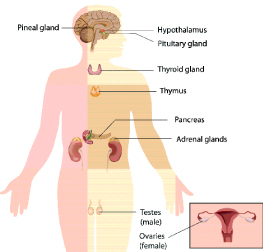Body Anatomy and Teenage Hormones
“TEENAGER” appears to be the expressive idiom for uncontrollable hormones as adolescent bodies experience various physiological changes, including skin and body transformations resulting in unwelcome acne and weight gain directly affecting a teenager’s self-image. It is a complicated time of life for these young men and women. Professionally speaking, licensed aestheticians should pay close attention to this important youthful consumer market and offer specialized skin treatments in their spas or skin care clinics to serve teenage skin care needs.
To gain understanding of the complexities in a teenager’s body that directly affects their skin and self-image, it is imperative for aestheticians to have a basic knowledge of the human anatomy as it relates specifically to teenagers.
 The human body is made up of tissues possessing assortments of similar cells specialized to perform a specific function. Acting in concert, tissues fall into five main categories: muscle; nervous tissue; blood; epithelial tissue covering surfaces and forming glands; and connective tissue (including bone), which supports organs.
The human body is made up of tissues possessing assortments of similar cells specialized to perform a specific function. Acting in concert, tissues fall into five main categories: muscle; nervous tissue; blood; epithelial tissue covering surfaces and forming glands; and connective tissue (including bone), which supports organs.
Functioning with the skeleton, muscles generate the principal energy to move and are dependent on a healthy nerve and blood supply. The cardiovascular system’s fundamental function is to pump blood around the body and all organs, including the significant skin appendage, relying on a supply of oxygenated blood and elimination of toxic waste products. The immune system – skin being the largest immune organ – provides chemical, cellular and physical protection against disease, including malfunctions of the body. A healthy digestive system also depends on the proper functioning of the immune and nervous system.
Psychological health is an aid to efficient digestion. The nervous system works with endocrine glands to monitor and maintain other systems. Hormones are the chemical messengers secreted by the endocrine glands and the specialized tissue in their organs. The endocrine system initiates the changes that take place at puberty and are responsible for hormone producing glands.
The word hormone literally means, “to spur on.” Each hormone is a complex chemical substance produced and secreted into the bloodstream by the endocrine gland, or secreted by specialized cells in other organs such as parts of the gastrointestinal tract or heart. Functions related to hormones include metabolism (the breaking down or building of chemical elements), water and mineral balance, growth and sexual development, and the body’s reaction to stress in response to the nervous system.
Hormones reach every part of the body and the membrane of every cell has receptors for one or more hormones that stimulate or retard a specific body function. The hypothalamus, located at the base of the brain, acts as the mastermind that coordinates hormone production, producing regulatory, or releasing, hormones; these travel a short distance through special blood vessels and nerve endings to the pituitary gland, often referred to as The Master Gland.
The pituitary gland is one of the least studied organs. It is located under the brain in the hypophyseal fossa of the skull and is an oval, bean-shaped, symmetrical, brownish-red organ. Compounding the inaccessibility of the tissue, the pituitary contains several types of hormone-producing cells whose number, endocrine activity and morphologic features are affected by changes in the endocrine environment, such as puberty.
Puberty is the term for the developmental change in a young body. Puberty by and large begins between the ages of 7 to 13 in girls and 9 to 15 in boys. When a young boy or girl begins to reach a certain age as dictated by genetic programming due to inherited differences, the brain discharges a special hormone that begins the change by letting loose a gonadotrophin-releasing hormone, or GnRH. When GnRH reaches the pituitary gland, this gland releases into the bloodstream two more puberty hormones: luteinizing hormone (LH) and a follicle-stimulating hormone called FSH. Both boys and girls have these hormones in their bodies.
For boys these hormones travel through the blood stream and give the testes the signal to begin production of testosterone. Testosterone is a steroid hormone from the androgen group and responsible for most changes in the young male body during puberty. Facial hair and voice transformation occur during this time as well. Also important to note is the major role testosterone plays in acne due to the stimulation of the sebaceous follicle. The skin is a major site of androgen metabolism and a primary target for the effects of androgens where sebum production is a sensitive indicator of its activity. Acne as it relates to teenagers will be discussed later in this editorial.
In girls, FSH and LH target the ovaries that contain eggs since birth. These hormones stimulate the ovaries to begin producing another hormone called estrogen. Estrogens are steroid compounds primarily produced by the ovaries and diffuse across a cell’s membrane. In addition, when it comes to teenage acne it is of value to understand that estrogens do not significantly affect the proliferation of the sebaceous glands and have been studied for the hormone’s ability to suppress activity. Due to this hormone on sebaceous inhibition, many physicians medically prescribe estrogen dominant birth control pills to female teenage patients as a remedy for acne management. However, it is important to note that birth control pills may have negative side effects in young girls, such as weight gain, causing depressing impact on their body image. 
Fat cells are also sources of estrogen; however, some of the estrogens are also produced in smaller amounts by supplementary tissues such as the liver, adrenal glands and the breasts. Estrogen, along with FSH and LH, causes a young girl’s body to mature.
During this hormone influx, it is not surprising many teenage girls and boys experience difficulties adapting to their changing body, emerging sexuality and emotional turbulence. Self-image becomes important during this transition, which also includes having clear skin.
Hormonal imbalance in teenagers is more common than we know. Among some of the indications and side effects are mood swings, depression, insomnia, aggression, confusion, withdrawal from social interactions, emotional instability, headaches, weight gain or loss, and acne of the face and back. When using an intake form for skin evaluation, these benchmark indicators should be used for information gathering that can lead to the success or failure of a professional treatment.
Body Image for Teenagers
According to Maslow’s Hierarchy of Human Needs, the order of importance is:
- Self-actualization
- Self-esteem
- Love and belonging
- Safety and security
- Physiological needs
Psychologist Abraham Maslow first introduced his hierarchy concept in 1943. This simple information is important when evaluating basic human self-worth and needs when taking information in your intake evaluation skin care form. I have used this scale when working with clients with low self-esteem concerning their skin and physical appearance. It has been a valuable tool in my private practice and education for over 25 years. 
Teenager’s social needs are important because it revolves around friendships and romantic attachments to validate their self-esteem. Self-esteem is important because it means feeling good about one’s self.
Body image to young men and women is how they view their physical self. It overlaps into their daily life whether they feel attractive and if others approve of their appearance. During puberty and social development, many teenagers struggle with their self-esteem and body image primarily due to the many changes their body and skin is going through. These changes, coupled with the desire to be accepted by their peers can cause a destructive cycle of comparison with other teenagers.
One very important body image to a teenager is their skin and the most common skin disorder is acne.
 Teenage Acne and Boosting Confidence
Teenage Acne and Boosting Confidence
Acne is not an endocrine disorder. However, normal circulating levels of androgens from the gonads and adrenals are absolute requirements. The fact remains that without a source of androgens, the sebaceous glands would remain small.
In addition, adrenal glucocoricosteriods play a collaborative role. These potentate the effects of androgens and have an “influence” over the end organ sensitivity where they influence the capacity of the follicle to form comedones, eventually converting into pustules, papules and cysts to a full blown acne.
Basic research on the causes of acne links its occurrence to the biological changes that take place as young people mature from childhood to adolescence. Rising hormone levels during puberty result in the enlargement of the sebaceous glands of the skin. This is brought about by increased activity of the endocrine glands, which secrete hormones that influence around parts of the body, including sebaceous glands.
The age onset of teenage acne occurs in puberty. This disease can begin at age 10 to 17 for females and age 14 to 19 in males, however acne can be more sever in adolescent boys than in girls primarily due to the surge of androgens.
The psychological impact of acne as perceived by teens is viewed as a facial disfigurement and a social stigma. Pizza face is a term often used by other adolescents to describe a teenager suffering with acne, making this skin condition a difficult life experience impacting their self-esteem, self-image and social interaction with others.
Acne is a disfiguring disease and its victims are often derided and worst yet, shunned by their peers. A common result is loss of confidence. Acne frequently worsens when emotional stress is imminent. Pubertal acne arrives at the worst possible time in life when tremendous psychological and bodily transformations are taking place. Anxiety can greatly aggravate the disease and can compromise acne therapy prolonging treatment and causing resistance to healing.
In your clinical treatment of a teenage acne disorder, it is important to be aware of their emotional well-being to help you boost their confidence. A teenager’s body language will often alert you to their overly tense and nervous demeanor.
Be aware of the teenager’s comfort level and follow these simple rules when first meeting your young and inexperienced client:
- Explore the teenager’s own views regarding their skin and self-image.
- Ask questions about school, job, diet and use of drugs. (Marijuana and other drugs increase the severity of acne.)
- Speak frankly about treatment to avoid unrealistic expectations leading to disappointment.
- State that acne is not contagious and is not an infection. Educate them on what really is happening with their skin and this disease.

More teenage girls than boys tend to become pickers and pressers. Pickers try by various means to rid their skin of acne lesions, which only cause further infection. Because of this, it is important to ask the teenager if they are manually picking their skin and explain this will prolong the disorder by crushing comedones, provoking inflammation and causing life-long scarring. Self-excoriation is generally linked to their morphopsychological image of acne; therefore treatment therapy can become a challenge if the teenager is a picker. This is a real problem that can also lead to further poor self-image because it worsens the condition. Teenage girls are generally more concerned about their skin than boys and more likely to seek a professional skin care treatment by an aesthetician. However, it has been my experience when working with teenagers that once a young man begins to see positive results from the clinical acne treatment, their self-confidence elevates and commitment to therapy remains loyal.
In conclusion, when trust and respect is established between the teenager and aesthetician, anxious adolescent clients are more likely to follow your therapeutic regimen and will achieve a positive outcome leading to higher personal confidence. Providing acne teen skin treatments and continuance of care in your spa or clinic can be extremely rewarding, leading to a new generation of clientele to build on the success of your skin care business.
 Christine Heathman CME, LMT is a licensed master aesthetician, aesthetic pioneer and nominated Legend in American aesthetics who has practiced clinical skin care for over 25 years. She is a powerful speaker, world-wide lecturer, educator, author of several skin manuals, has written hundreds of skin science editorials, selected to the editorial board of a leading skin journal and is an innovator in the research and development of unconventional and progressive skin care and protocols used in the most prestigious skin care and medical clinics all over the world. Owner and CEO of GlyMed Plus, a professional only skin care line, she has appeared several times on the popular health care program, The Doctors. Heathman has remained loyal to the professional, applying her extensive knowledge and experience to facilitate American aesthetics and remains a commanding and authoritative influence in the skin care industry today.
Christine Heathman CME, LMT is a licensed master aesthetician, aesthetic pioneer and nominated Legend in American aesthetics who has practiced clinical skin care for over 25 years. She is a powerful speaker, world-wide lecturer, educator, author of several skin manuals, has written hundreds of skin science editorials, selected to the editorial board of a leading skin journal and is an innovator in the research and development of unconventional and progressive skin care and protocols used in the most prestigious skin care and medical clinics all over the world. Owner and CEO of GlyMed Plus, a professional only skin care line, she has appeared several times on the popular health care program, The Doctors. Heathman has remained loyal to the professional, applying her extensive knowledge and experience to facilitate American aesthetics and remains a commanding and authoritative influence in the skin care industry today.
Want to read more?
Subscribe to one of our monthly plans to continue reading this article.